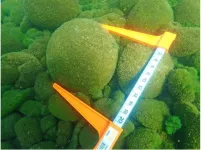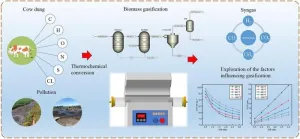(Press-News.org) Over 4,800 years in the Northern Rockies during wet periods and dry periods, subalpine forests consistently recovered from wildfires, growing back vegetation and leaving evidence of their resilience in lake sediment cores.
Kyra Clark-Wolf, now a CU Boulder postdoc with the North Central Climate Adaptation Center (NC CASC), led the study as part of her dissertation research. NC CASC is a partnership of CU Boulder and the United States Geological Survey.
“I thought we might see different ecosystem responses to past fires between wet and dry periods,” said Clark-Wolf. “But what we found was that there wasn't really a clear difference based on climate, but just a lot of variability within the record, which is something that hasn't been shown before.”
Fires have always been part of subalpine forest ecology in the Northern Rockies, but scientists haven't been able to study forest recovery from those forests in detail— until now. Results from the new analysis of lake sediment cores from a Montana subalpine lake, published today in the Journal of Ecology, were surprising.
The results detail the remarkable resilience of Northern Rockies subalpine forests to fire in the past. But the research also raises an important question: How resilient will these forests fare in the future?
“As we look to the present into the future, we know that our climate conditions are increasingly getting outside of the range of variability that we've experienced in recent millennia,” said Phil Higuera, former CIRES visiting fellow, director of the University of Montana’s Paleoecology and Fire Ecology Lab, and a co-author of the study. “Global temperatures are getting warmer and conditions are getting drier.”
Scientists often rely on tree-ring records to understand the history of fire in forests. Yet, fires in subalpine forests are rare, burning on average every 100 to 250+ years. These fires typically kill most trees, along with the history they record.
Like tree rings, lake sediment cores act as natural archives, but they document a much larger time frame, producing records that date back thousands of years compared to centuries. As sediment settles into lake bottoms in layers they accumulate, with the oldest at the bottom and youngest at the top. Sediment preserves pollen, charcoal, and other indicators of past ecosystems.
“Lake sediment records integrate everything that’s happening on the landscape so we can understand ecosystem responses,” said Clark-Wolf. “For example, pollen tells us what types of plants were present on the landscape before and after fires.”
This paper built on another recent study in which the research team created long-term records for 12 subalpine lakes in Montana and Idaho, resulting in a full landscape history of fire in the region. That work showed that present-day fire activity is still well within the range of the variability experienced over the past 2500 years.
Collecting the lake sediment samples in a beautiful subalpine lake was cold, arduous work, Clark-Wolf said. After camping in near-freezing temps, the team set out on an inflatable raft they anchored in the center of the lake. While balancing on the small raft, they’d screw metal rods together to lower a long slender coring tube over 50 feet to the lake bottom. Then, layer after layer, they hand-drilled through years of sediment at the bottom of the lake. The oldest sediment core measured about seven meters long, 7600 years old, with layers indicating time stamps like the Mount St. Helens and Crater Lake eruptions.
After a few days of sediment collection, they brought the 13 cores back to the lab where they sliced the mud-like samples into hundreds of half-centimeter intervals.
“Each one of those slices is a snapshot of the ecosystem over about a 10-year time period,” said Higuera. “When we're talking about thousands of years, a 10-year time slice is really high resolution. And that's what allows [Clark-Wolf] to be able to characterize how fires impacted the ecosystem, and how long it took for vegetation [and other ecosystem components] to return to what they were like before each fire occurred.”
Looking ahead, the study concluded that a modest increase in fire activity wouldn’t be uncharacteristic for the Northern Rockies subalpine ecosystems—yet.
“Connecting the dots, it's clear that we expect to see things change in these forests, and given global warming, we clearly expect to see more widespread burning. Eventually burning will likely exceed what these forests have experienced in the past, something we’re starting to see in other regions, like the southern Rocky Mountains.” Phil Higuera.
END
Subalpine forests in the Northern Rockies are fire resilient—for now
2023-10-17
ELSE PRESS RELEASES FROM THIS DATE:
Unique marimo threatened by rising lake temperatures
2023-10-17
Rising lake water temperatures threaten the survival of marimo, unique algal balls found only in cold lakes. Kobe University researchers clarified that the warmer it gets, the more the inward decomposition outpaces the outward growth of these life forms, making them increasingly fragile.
Moss balls, or “marimo” in Japanese, are popular pet water plants that are not a moss but a special growth form of filamentous algae. They are found naturally in lakes in northern Japan and cold lakes of ...
How to scientifically, efficiently, and cost-effectively treat the wastewater generated from anaerobic digestion?
2023-10-17
The resource utilization of waste is an important means to implement the construction of ecological civilization. Agricultural waste contains rich renewable resources and has high potential value in fertilization and energy conversion. Anaerobic digestion technology is a promising technology for treating agricultural waste. Anaerobic digestion refers to the digestion technology in which organic matter is decomposed into CH4, CO2, H2O and H2S by facultative bacteria and anaerobic bacteria under anaerobic conditions, which can transform solid organic matter into soluble organic matter. Not only does it have the advantages of stable process and low operation cost, the biogas produced can also ...
Novel hydrogel finds new aptamers, or ‘chemical antibodies,’ in days
2023-10-17
UNIVERSITY PARK, Pa. — One double-helix strand of DNA could extend six feet, but it is so tightly coiled that it packs an entire sequence of nucleotides into the tiny nucleus of a cell. If that same DNA was instead split into two strands and divided into many, many short pieces, it would become trillions of uniquely folded 3D molecular structures, capable of bonding to and possibly manipulating specifically shaped molecules — if they’re the perfect fit.
These short, single-stranded segments of DNA or RNA are called aptamers, also known as “chemical antibodies.” According to Penn State researchers, ...
Virtual reality helps people with hoarding disorder practice decluttering
2023-10-17
Many people who dream of an organized, uncluttered home à la Marie Kondo find it hard to decide what to keep and what to let go. But for those with hoarding disorder — a mental condition estimated to affect 2.5% of the U.S. population — the reluctance to let go can reach dangerous and debilitating levels.
Now, a pilot study by Stanford Medicine researchers suggests that a virtual reality therapy that allows those with hoarding disorder to rehearse relinquishing possessions in a simulation of their own home could help them declutter ...
Fluctuating blood pressure: a warning sign for dementia and heart disease
2023-10-17
A new study by Australian researchers has shown that fluctuating blood pressure can increase the risk of dementia and vascular problems in older people.
Short blood pressure (BP) fluctuations within 24 hours as well as over several days or weeks are linked with impaired cognition, say University of South Australia (UniSA) researchers who led the study.
Higher systolic BP variations (the top number that measures the pressure in arteries when a heart beats) are also linked with stiffening of the arteries, associated with heart disease.
The findings have been published in the journal Cerebral Circulation – Cognition and ...
Significant gaps in UK public awareness of tell-tale cancer signs in kids and teens
2023-10-17
There are significant gaps in the UK public’s awareness of the tell-tale signs and symptoms of cancer in children and teens, with just a third of adults expressing confidence in being able to recognise them, find the results of a nationally representative survey published online in the journal Archives of Disease in Childhood.
Public awareness of the cancer signs and symptoms in this age group is much lower than it is in adults, suggesting the need for initiatives to plug this knowledge gap, say the researchers.
Childhood cancer is the leading cause of ...
ChatGPT may be better than doctors at evidence-based management of clinical depression
2023-10-17
ChatGPT, the AI language model capable of mirroring human conversation, may be better than a doctor at following recognised treatment standards for clinical depression, and without any of the gender or social class biases sometimes seen in the primary care doctor-patient relationship, finds research published in the open access journal Family Medicine and Community Health.
However, further research is needed into how well this technology might manage severe cases as well as potential risks and ethical issues arising from its use, say the researchers.
Depression is very common, and many of those affected turn first to ...
Immersive virtual reality seems to ease cancer patients’ pain and distress
2023-10-17
Immersive virtual reality—digital technology that allows a person to experience being physically present in a non-physical world—seems to ease the pain and distress felt by patients with cancer, suggests a pooled data analysis of the available evidence published in BMJ Supportive & Palliative Care.
The technology may also have potential for people with other distressing long term conditions, such as multiple sclerosis (MS), kidney disease, and dementia, the findings indicate.
As the physical and practical costs of virtual reality technologies have fallen, interest in their use for improving patients’ quality of life has ...
Older siblings and childhood tonsil removal linked to heightened risk of inflammatory arthritis
2023-10-17
Having older siblings and childhood tonsil removal are linked to a heightened risk of ankylosing spondylitis, a type of chronic inflammatory arthritis, finds a large study published in the open access journal RMD Open.
The findings lend weight to the theory that childhood infections have a role in the development of the condition, which is characterised by inflammation of the spine, joints, and tendons, resulting in pain, stiffness, and fatigue.
While genetic predisposition is the leading cause of the disease, early life environmental factors ...
Antibiotic-resistant bacteria mapped in Ghana
2023-10-17
Some strains of heavily antibiotic-resistant bacteria in Ghana are not successful at spreading outside of the hospital, suggesting that control measures can be focused on clinical settings to help curb treatment-resistant infections.
Scientists, from the Wellcome Sanger Institute, Oslo University Hospitals, the University for Development Studies, Ghana, and collaborators, used a One Health1 approach to understand the spread of antibiotic resistance in Klebsiella pneumoniae (K. pneumoniae) bacteria in Ghana. It is a bacterial species ...


